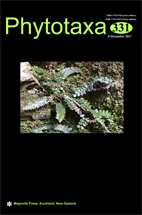Abstract
In the present study, we examined the karyotype data of subg. Cyathophora and sect. Bromatorrhiza, to determine some disputed karyotypes (e.g., A. spicatum and A. fasciculatum), and further to estimate the karyotype evolution along their phylogenetic frameworks. Our results revealed a fairly stable basic chromosome number (x = 8) in subg. Cyathophora, and we therefore revised x = 8 as the basic chromosome number of A. spicatum, rather than x = 10 mostly due to misidentifications concerning A. fasciculatum. The karyotype asymmetry analyses for subg. Cyathophora indicated that, the karyotype evolution for diploid species showing a high karyotype similarity was mainly due to intrachromosomal changes, while the interchromosomal changes were linked to the evolution of tetraploid populations. However, indeed different dysploid basic chromosome numbers (x = 7, 10, 11) and greatly different karyotype patterns occurred in sect. Bromatorrhiza, corresponding to the subsections revealed by molecular evidence. The combined evidence suggested that species with x = 11 compose a segmental allotriploid complex. It was also indicated that karyotype pattern of polyploids usually is closely related with their diploid progenitors.

